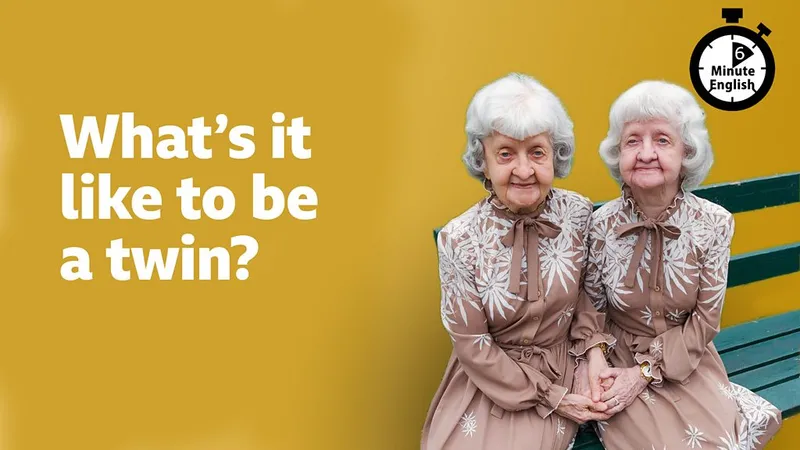Neil Hello, this is 6 Minute English from BBC Learning English. I’m Neil.
Beth And I’m Beth.
Neil In this episode, we’re talking about twins. Non-identical, or fraternal, twins come from two separate eggs and share half their genes. More uncommon are identical twins, who come from a single fertilised egg and share 100% of their genes.
Beth As humans, we’re fascinated by twins. When people discover that someone’s a twin, they start asking all kinds of questions. What question would you ask a twin, Neil?
Neil Oh, probably quite an annoying one. Maybe… “Do you share each other’s thoughts?”
Beth Ooh! I might ask, “If one of you is hurt, does the other one feel the pain?”
Neil Hmm. Interesting.
** Beth** Well, some common questions for twins include: “Do you have psychic powers? Have you ever swapped boyfriends? And do you have the same dreams?” But according to Anand Jagatia, who presented a recent episode of BBC World Service’s CrowdScience all about twins…
Anand Jagatia …if you meet a twin and you ask them one of these questions, don’t be surprised if they roll their eyes at you.
Neil Ask a twin about psychic powers and they might roll their eyes – a way of showing boredom or irritation. But nevertheless, twins continue to capture our imagination, and in this episode we’ll be finding out why, using some useful new words and phrases.
Beth And remember, you’ll find all the vocabulary for this episode, along with a quiz and a worksheet, on our website, bbclearningenglish.com.
Neil First, I have a question for you, Beth. These days, twins are more common than you might think. In fact, one in every 42 babies is born a twin. But do you know which famous Hollywood star is a twin? Is it:
a) Jennifer Lawrence,
b) Angelina Jolie, or
c) Scarlett Johansson?
Beth Ooh, I don’t know. I’m going to guess Scarlett Johansson.
Neil Well, we’ll find out the answer at the end of the programme. Professor Karen Dillon is the author of a book on twins in American literature and a twin herself. Here, she discusses the good and bad sides of twinship with Anand Jagatia, for BBC World Service programme CrowdScience:
Anand Jagatia Being a twin isn’t always plain sailing.
Karen Dillon Yeah, it is nice – there’s never that fear, because you’re going through school together, you’re sometimes in the same class together, you’re making friends together. So, all of those milestones of childhood, in some ways, are made easier for twins. But then the older you get, the more you realise how much people really think of you as a twin rather than as an individual.
Beth Twins go through many childhood milestones together. A milestone is an important stage of development, so a childhood milestone could be something like your first day at school.
Neil But being a twin isn’t always plain sailing – an idiom meaning easy and problem-free. Many twins find it hard to establish their own identity as a separate and unique individual.
Beth Our fascination with twins also comes from the age-old ’nature versus nurture’ debate: how much of our lives is determined by nature, the genetics we’re born with, and how much by nurture, the environment we grow up in? Because twins are so genetically similar, differences between them tell scientists a lot.
Neil Here’s presenter of BBC World Service programme CrowdScience, Anand Jagatia, discussing this with Helena De Bres, a philosopher at Wellesley College, Massachusetts, and – that’s right – another twin.
Anand Jagatia Yeah, you hear about twins that were separated at birth, grew up in different parts of the world, and they kind of have these eerily similar life courses. And you think, “Gosh! How much choice have I had over the way my life’s turned out?”
Helena De Bres Absolutely, yeah. There’s that really famous case of the Jim Twins, who were reunited at age 39 after being separated at birth, and they just had so many similarities – it was crazy! They both married someone called Linda and then divorced her for someone called Betty. They both named their dog ‘Toy’. It was, like, ridiculous!
Beth The twins, Jim Lewis and Jim Springer, were separated at birth. The phrase separated at birth can be used to describe two people with strong similarities. Although, in this case the twins were literally separated and adopted by different parents at birth.
Neil When the Jims were reunited in the 1970s, everyone was amazed at how similar their lives were. Anand used the adjective eerie, meaning strange in a frightening, mysterious way. And Helena says, “It was crazy,” using crazy to mean strange and fantastic.
Beth Yes, I think ‘strange’, ‘mysterious’ and ‘fantastic’ describe being a twin quite well. OK. Neil, it’s time to reveal the answer to your question.
Neil I asked which Hollywood star is a twin, and you said, “c) Scarlett Johansson”…
Beth I did.
Neil …which was the right answer.
Beth Yay!
Neil Let’s recap the vocabulary we’ve learned, starting with roll your eyes – to move your eyes upwards to show you are bored or annoyed.
Beth A milestone is a significant stage in the development of something.
Neil The idiom it’s not plain sailing describes difficult and problematic situations.
Beth The phrase separated at birth can describe two people who are unusually similar. It also refers to siblings who were adopted by different parents at birth.
Neil And the adjective eerie means strange in a frightening and mysterious way.
Beth And finally,if someone says,“It was crazy!” they mean it was strange and fantastic. Once again, our six minutes are up, but remember – you can find worksheets, quizzes and loads more resources to improve your English on our website, bbclearningenglish.com. See you there soon, but for now – goodbye!
Neil Goodbye!
